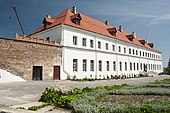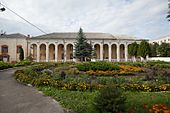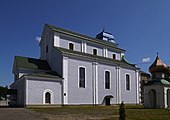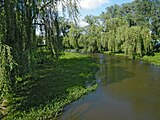Dubno
You can help expand this article with text translated from the corresponding article in Ukrainian. (July 2022) Click [show] for important translation instructions.
|
Dubno
Дубно | |
|---|---|
 Castle | |
| Coordinates: 50°23′35″N 25°44′06″E / 50.39306°N 25.73500°E | |
| Country | |
| Oblast | Rivne Oblast |
| Raion | Dubno Raion |
| Hromada | Dubno urban hromada |
| First mentioned | 1100 |
| Magdeburg law | 1498 |
| Government | |
| • Mayor | Vasyl Antoniuk |
| Area | |
• Total | 27 km2 (10 sq mi) |
| Elevation | 200 m (700 ft) |
| Population (2022) | |
• Total | 36,901 |
| • Density | 1,400/km2 (3,500/sq mi) |
| Time zone | UTC+2 (EET) |
| • Summer (DST) | UTC+3 (EEST) |
| Postal code | 35600—35608 |
| Area code | +380-3656 |
| Website | www |
 | |
Dubno (Ukrainian: Дубно, IPA: [ˈdubno]) is a city and municipality located on the Ikva River in Rivne Oblast (province) of western Ukraine. It serves as the administrative center of Dubno Raion (district). The city is located on intersection of two major European routes, E40 and E85. The city is estimated to have a population of 36,901 (2022 estimate)[1]. It is located within the historic region of Volhynia.
In Soviet times it was home to the Cold War facility Dubno air base. The city is also famous for its fortress.
History
[edit]Middle Ages
[edit]First mentioned in a chronicle of 1100, when it was in possession of Yaroslav the Wise's grandson David of Brest [citation needed], Dubno was even a seat of local princes for a short period of time. In 1240 the town was raided by the Mongols. In the early 14th century the region was the subject of Polish-Lithuanian rivalry, as a result of which Dubno became part of the latter. However, soon after with the Union of Krewo (1385), it came under Polish influence as part of the Polish-Lithuanian Union. In 1386 King Władysław II Jagiełło granted Dubno along with nearby Ostróg to magnate Feodor Ostrogski and since then as a private town it has belonged for over 200 years to the influential Ostrogski family.[2] Later, it became a notable stronghold in Volhynia. Granted city rights in 1498 by Alexander Jagiellon, the town attracted many foreign settlers, most notably Jewish and Armenian. As such, it became the seat of one of the oldest and most vibrant Jewish communes in Central-Eastern Europe. Since 14th century owned by the mighty Ostrogski family, who built the Dubno Castle during the times of Konstanty Wasyl Ostrogski.
Early modern period
[edit]
Between 1489 and 1506 the castle was significantly expanded by Konstanty Ostrogski, who made it a modern fortress, one of the strongest in the area. After 1566 Dubno was part of the Volhynian Voivodeship of the Lesser Poland Province. During the Polish-Russian War of 1605–1618 in 1617, Prince and future King Władysław IV Vasa resided in the city.[2]
With the death of Janusz Ostrogski in 1619, the last of his kin, the area was inherited by his brother-in-law Aleksander Zasławski of the cadet branch of the Ostrogski family. About that time it was again modernized to stand up to the standards of renaissance warfare and modernization of artillery. Finally, in 1673 it passed to the Lubomirski family, which built a new palace within the fortress walls.[2]
The 13th Polish Infantry Regiment, est. in 1766, was stationed in Dubno.[3] In the 1780s the castle underwent yet another modernization and was rebuilt as a residential manor, mostly losing its fortified character. In 1781 King Stanisław August Poniatowski visited Dubno.[2] By that time, the town was the largest settlement of the Volhynian Voivodeship and arguably the most notable centre of the area. In spite of the Partitions of Poland the town initially flourished after the first partition, as the szlachta register was moved there from Lwów, which was annexed by Austria. Dubno itself was annexed by Imperial Russia in 1795 during the Third Partition of Poland, after which the nobility's register was moved to Kyiv and the town lost its importance, gradually falling into neglect.
Late modern period
[edit]
As part of anti-Polish repressions, the Russian administration closed down the Bernardine and Carmelite monasteries and confiscated them from the Catholic Church.[2] In 1870 Dubno was declared a Fortified Town, which imposed serious limitations on settlement and housing construction, further limiting the development. However, it remained a notable centre of commerce, most notably because of numerous Czech settlements around the town, that gave it the nickname of the brewery of Volhynia. The castle was ruined in 1915 during World War I.

Retaken by Poland after the state's independence in 1918 and finally granted to Poland in the Peace of Riga, it was a seat of a powiat and a notable military garrison of both the KOP, and the Polish Army, with the 43rd Rifle Regiment (part of the 13th Kresy Infantry Division), and the 2nd Regiment of Mounted Artillery (part of Volhynian Cavalry Brigade) stationed here. Dubno also was the seat of Papal Eastern Seminary (Papieskie Seminarium Wschodnie). In 1935 a large prison was started to be built, the third biggest in Poland at that time. Between 1932 and 1939 the castle was being rebuilt in its original form, but the works were stopped by the outbreak of World War II. In 1937, its population was app. 15,500, out of which Jews made 45%, Ukrainians 29%, and Poles 26%.
World War II and post-war
[edit]Occupied by the Soviet Union following the Molotov–Ribbentrop Pact of 1939, it was subject to harsh policies of the NKVD. The uncompleted prison was taken over by the NKVD in December 1939 and was used for political prisoners from all parts of Soviet-occupied Poland. Between 1500 and 3000 prisoners were kept there in harsh conditions, with new inmates arriving after the previous ones were successively transported to Gulag and other Soviet prisons. In 1940 most of the local Poles were arrested and resettled to various Soviet Gulags and prisons throughout the USSR.
In 1941, following the outbreak of Soviet-German War, on 24 June and 25 June 1941, approximately 550 prisoners of the Dubno prison were executed by the withdrawing NKVD while only 8 of them survived. About that time in the vicinity of the town (and around Lutsk and Brody) a large tank battle was fought. In the Battle of Brody (1941) the German 1st Panzer Group under Ewald von Kleist managed to break the counter-attack by Soviet 9th and 19th Mechanized Corps, and 8th Mechanized Corps. 8th Corps Tank Group took Dubno and held it for 5 days before it was retaken by stronger German forces' (under Konstantin Rokossovski, Nikolay Feklenko and D.I Rybjasev, Commander of 8th Corps Tank group was brigade commisar N.K. Popel, respectively). Soon afterwards the town was occupied by Germany. During the occupation, the Germans blew up the historic town hall from the 18th century.[2] The Germans operated a Nazi prison,[4] a Wehrmacht-operated military prison and a subcamp of the Stalag 360 prisoner-of-war camp in Dubno.[5]
In the second half of 1943, Dubno became a shelter for ethnic Polish population of Volhynia, who came here to escape the Volhynian Genocide. The town was defended by a unit of Polish self-defence, which was tolerated by German authorities. On February 28, 1944, the Germans evacuated Poles from Dubno to Brody, and then to the Reich, where they became slave workers. In 1944 Dubno found itself again under Soviet occupation and after the war it was taken from Poland and annexed by the Soviet Union in accordance to the Potsdam Conference.
In 1959 the Roman Catholic Church of Saint John Nepomuk was closed down by the Soviets.[2] It was reopened in 1993, thanks to the efforts of the local Polish community.[2]
After the dissolution of the Soviet Union, Dubno became part of Ukraine.
Jewish history
[edit]
According to the census of 1897, Dubno had a population of 13,785, including 5,608 Jews. The main sources of income for the Jewish community were trading and industrial occupations. There were 902 artisans, 147 day-laborers, 27 factory and workshop employees, and 6 families cultivating land. The town had a Jewish hospital and several chederim (Jewish schools). The earliest date given in connection with the Jews of Dubno is the beginning of the 17th century. In 1650, there were 47 Jewish and 141 Christian taxable households.
Dubno is perhaps best known within the Jewish world as the long-time home of Rabbi Yosef Yaakov Sabatka, "Yosef Yoske of Dubno", and of Jacob ben Wolf Kranz, the "Dubno Maggid" (or Dubner Maggid). Hayyim Mordecai Margolioth, author of Sha'are Teshuva, was Rabbi there c. 1810.
The nineteenth century intellectual Joel Baer Falkovich was also born in Dubno and was a pioneer of the Haskalah there, although he relocated to Odessa later in life.
The Nazi occupation of Dubno began on 25 June 1941. During Passover of 1942, a large ghetto was created in the city. The ghetto included the local Jewish population as well as many refugees from other parts of Poland who had fled east. Within the Dubno ghetto, all Jews were identified by the Star of David on an armband. With 12,000 people in a small area, the ghetto became overcrowded and hunger/sickness were abundant. After 24 October 1942, the Jewish community ceased to exist.[6]
Most of the local Jews (roughly 12,000, that is 59% of pre-war inhabitants of the town) were murdered in the Holocaust. They were shot in mass executions by the SS Einsatzgruppe outside of the city. A detailed description of the mass murder was given by Hermann Friedrich Graebe at the Nuremberg trials. A young German officer of the German 9th Infantry Regiment, Axel von dem Bussche, witnessed the executions and reacted by joining the resistance movement against Hitler. Around 300 Jews managed to survive the massacres.[6]
Gallery
[edit]-
Lubomirski Palace
-
Lutsk Gate
-
Carmelite monastery
-
Bernardine Monastery
-
Ikva River in Dubno
-
Dombrowski manor
-
Church of Saint John Nepomuk
-
Saint Elijah church
-
Church of the Ascension
-
Memorial to the victims of Communist regime
-
Merchant's house
-
House of contracts
-
Grave of Yosef Yaakov (Yoska) Sabatka
People
[edit]- Yosef Yaakov (Yoska) Sabatka, Rabbi Yosef, Rabbi of Dubno
- Jacob ben Wolf Kranz, Dubner Maggid
- Axel Freiherr von dem Bussche-Streithorst
- Rafał Leszczyński (1650–1703)
- Aleksander Dominik Lubomirski
- Józef Karol Lubomirski
- Katarzyna Ostrogska (1560-1579)
- Stanisław Skalski, Polish fighter ace of the Polish Air Force in World War II, Brigadier General, participant of the Battle of Britain
- Wiktor Poliszczuk
- Joseph Soloveitchik
- Vyacheslav Ivanovich Zof
- Roman Toporow
International relations
[edit]Twin towns — Sister cities
[edit]Dubno is twinned with:
See also
[edit]- List of towns with German town law
- Battle of Warsaw (1920)
- Polish-Soviet War
- Polish-Soviet War in 1920
- German XLVIII Panzer Corps
- Operation Spark (1941)
- Taras Bulba a book in which Dubno plays a large part
References
[edit]- "Dubno (Rivne, Ukraine)". Flags of the World. Retrieved 20 November 2005.
- "Dubno". PWN (in Polish) (web ed.). 2002.
- "Dubno; Zamek". Wyjazd turystyczno-charytatywny na Kresy (in Polish). Archived from the original on 18 November 2005. Retrieved 20 November 2005.
- "Łuck-Brody-Dubno i T-34". Historycy.pl (in Polish). Archived from the original on 16 November 2004. Retrieved 20 November 2005.
- Specific
- ^ Чисельність наявного населення України на 1 січня 2022 [Number of Present Population of Ukraine, as of January 1, 2022] (PDF) (in Ukrainian and English). Kyiv: State Statistics Service of Ukraine. Archived (PDF) from the original on 4 July 2022.
- ^ a b c d e f g h Alf Sobczyński. "Kresy – przywracanie pamięci. Dubno". Gazeta Gazeta. Retrieved 1 October 2019.
- ^ Gembarzewski, Bronisław (1925). Rodowody pułków polskich i oddziałów równorzędnych od r. 1717 do r. 1831 (in Polish). Warszawa: Towarzystwo Wiedzy Wojskowej. p. 30.
- ^ "Gefängnis Dubno". Bundesarchiv.de (in German). Retrieved 10 December 2023.
- ^ Megargee, Geoffrey P.; Overmans, Rüdiger; Vogt, Wolfgang (2022). The United States Holocaust Memorial Museum Encyclopedia of Camps and Ghettos 1933–1945. Volume IV. Indiana University Press, United States Holocaust Memorial Museum. pp. 363, 642. ISBN 978-0-253-06089-1.
- ^ a b "Remember Jewish Dubno". 2018-07-21. Archived from the original on 2012-12-07. Retrieved 2013-06-24.
Bibliography of Jewish Encyclopedia
[edit]- P. Pesis, 'Ir Dubno we-Rabbaneha, Cracow, 1902;
- Regesty i Nadpisi, i. 339, 432, St. Petersburg, 1899;
- K. H. Margolyesh, in Ned. Khronika Voskhoda, 1887, p. 45.H
 This article incorporates text from a publication now in the public domain: Singer, Isidore; et al., eds. (1901–1906). The Jewish Encyclopedia. New York: Funk & Wagnalls.
This article incorporates text from a publication now in the public domain: Singer, Isidore; et al., eds. (1901–1906). The Jewish Encyclopedia. New York: Funk & Wagnalls. {{cite encyclopedia}}: Missing or empty|title=(help) ([1])- By : Herman Rosenthal, S. Janovsky & M. Seligsohn
External links
[edit]- Official City Website
- City Portal of Dubno
- Memorial to the Victims and Survivors of the Dubno Ghetto Archived 2012-12-07 at Archive-It
- History of Dubno
- Social network of the town of Dubno
- Сastles of Ukraine. (in Ukrainian)
- Soviet topographic map 1:100,000
- The extermination of the Jews of Dubno - a testimony at the Nuremberg trials by Hermann Graebe
- Location map via Encarta Maps
- News on-line

















